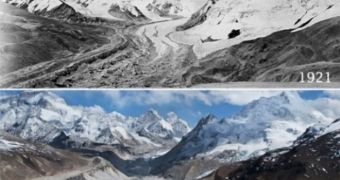While the controversy about how fast the world’s ice sheets and glaciers are melting on account of global warming rages on, one thing remains certain – there is at this point a dire need for experts to continuously monitor the situation. GlobGlacier was designed to do just that.
GlobGlacier is an initiative by the European Space Agency (ESA), whose goal is to keep an eye out on how glaciers around the world evolve over time. This includes finding the ones that are most affected by global warming, and also those that remain unchanged, or grow over time.
Antarctica, Greenland and the Arctic are the primary reservoirs of ice Earth has available. However, mountaintop glaciers also contain large amounts of freshwater, which are critically important for supporting billions of people.
As such, understanding how they are affected by global warming and climate change is very important, especially in the case of large glaciers such as those on the Himalayas and the Andes.
Satellites are shaping up to be the most reliable method of keeping an eye out on glaciers, and ESA is now a leader in these efforts. With GlobGlacier, it plans to create a critically-important, highly-detailed, global glacier inventory, Daily Galaxy reports.
The endeavor is part of the ESA Data User Element. It currently seeks to add more than 20,000 glaciers to the inventory, out of around 160,000 glaciers worldwide. After they are added, these structures will be constantly monitored from satellite.
Calculating changes in the extent and length of glaciers is an important aspect of these efforts. This capability can be achieved by taking time-lapse photos of the formation, and then extrapolating its motions from the datasets.
“Such data allow scientists to assess the overall pattern of changes in a larger region for a better determination of climatic change impacts,” explains the manager of the GlobGlacier project, Frank Paul. He is based at the University of Zurich, in Switzerland.
This work will be especially important for the Himalayas. The mountain chain holds immense glaciers, that together help nourish the thirst and crops of hundreds of millions of people.
If these glaciers are affected, then ensuing droughts would affect large areas in China, India and Pakistan, to name but a few countries. The economic impacts would be catastrophic.

 14 DAY TRIAL //
14 DAY TRIAL //